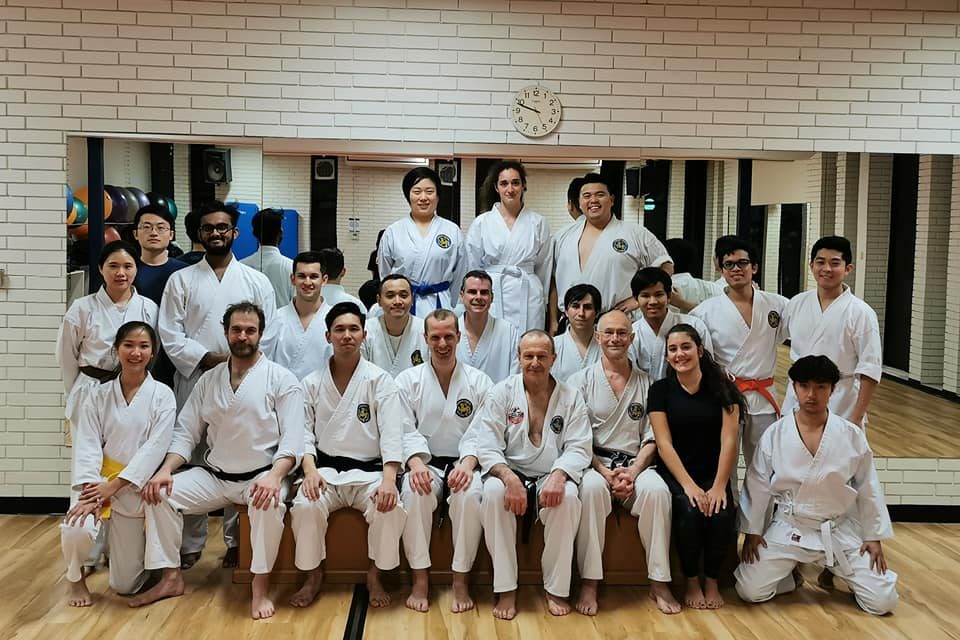The Ryukyu Islands are to the south west of Japan, east of China and north-east of Taiwan. The largest island in the chain is Okinawa. The Ryukyu have been influenced by China and/or Japan since medieval times. It is thought that Chinese martial arts were introduced to the Islands as early as the late 14th century. Since that time there has been a mixing of Chines martial arts and the indigenous Island martial arts. In 1477 the Ryukyu government of the day banned the citizenry from carrying weapons in an attempt to maintain strict control. The ban gave impetus to the development of unarmed self defence techniques and techniques that used fishing and agricultural tools as weapons (e.g. the nunchaku [pieces of wood joined by a rope or chain] is believed to have been developed from a rice flail). The techniques were taught in private to a small number of students by experienced masters. In the early 1600’s, the Japanese Satsuma samurai clan invaded the Islands and gained control of them. The Japanese warlords repeated the ban on carrying of weapons. The result was that the development of unarmed fighting and fighting styles with agricultural and fishing tools continued. The styles were often called te (pronounced tey and translated as “hand”).
Te practitioners recognised that the origins of the art was China. A number of masters went to China for further study. Between 1800-1900 te became known as karate (pronounced kara-tey) or toudi – both terms meaning “Chinese hand”.
In 1875 the Ryukyu officially became part of the Japanese empire. The first public demonstrations of karate took place in about 1903. At about that time karate entered the Ryukyu school system as a form of physical education. The result of this was:
- emphasis shifted from the practical application of techniques to the benefit of the physical exercise in performing the techniques.
- techniques that were considered too dangerous to teach school children were not taught or were modified or “hidden” and not explained in full.
- techniques began to be more rigid and abrupt with less flow. This suited teaching large numbers of students as it allowed the instructor to check the positions of each student on completion of each movement.
Karate came to Japan in the 1920’s. Its introduction was mainly due to the efforts of the Okinawan karate master Gichin Funakoshi. Masters from other karate styles followed Funakoshi to Japan. They modified karate to make it more attractive to the Japanese. In particular:
- The ideogram for “karate” was changed from “Chinese hand” to “empty hand”. This was ostensibly for the reason of identifying karate as an unarmed self defence technique and as representing transcending worldly desires during the pursuit of inner discovery. The real reason was probably the xenophobic Japanese nationalism of the day and the Japanese expansion into China at that time. Acknowledging the Chinese origin of karate would not have promoted have it in Japan. Other links with China were also removed. Names of forms that indicated a Chinese origin were changed.
- Other Japanese martial arts were based strictly on a hierachy and recognition via a graded approach. This was embodied by the coloured belt grading system. Karate copied this system.
- The Japanese principle of uniformity (as illustrated by the Japanese proverb deru kugi wa utareru “a portruding nail gets hammered own”) was strictly applied.
Ryukyu karate masters differed in their views about the merits of these changes.
The Japanes contribution to karate of organisation and uniformity did not result in reducing the number of styles of karate. The opposite has occurred. The number of styles has multiplied. The rate of multiplication increased when karate spread from Japan after the Second World War.
“Sport” karate commenced in Japan in the mid-1950’s. It was stimulated by karate spreading to the western world. It was felt that western minds readily grasped physical activity as a sport, but had difficulty with the concept of physical activity as a vehicle for self improvement. Since its introduction, different types sports karate competitions and rules have been used. Each attempted to minimise the danger of competitions and make them attractive. For these reasons the various rules have –
- limited the techniques that can be used and the areas that can be attacked.
- required boxing gloves or foot padding or other protective equipment to be worn.
- prohibited or limited grappling, throwing and locking techniques.
The effect of this is that in competitions many effective techniques cannot be used and there is a lack of concern in defending padded areas and areas that are not within the permitted target zone. The sporting aspect of karate is part of karate, however emphasising it tends to result in neglect in the aspects of karate that are not strictly necessary succeed in a competiton and leads to a distortion of the true nature of karate.
